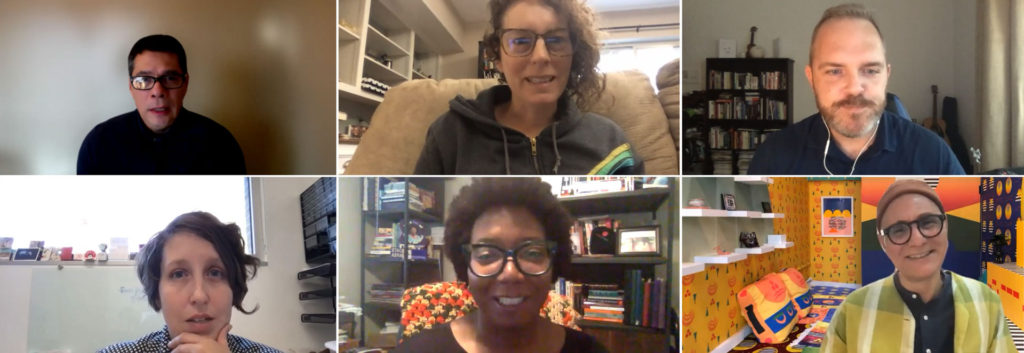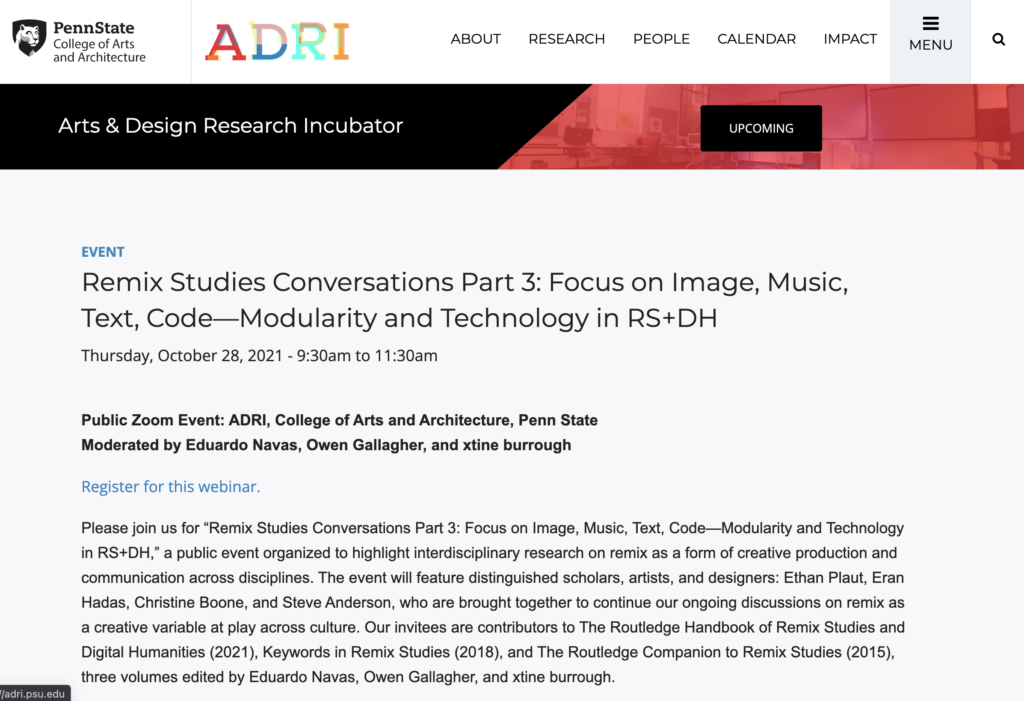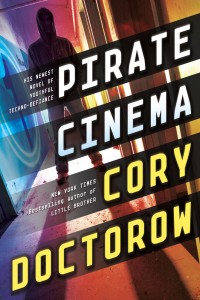
The focus of the discussion is on the role of remix in creative practices in art and design. Remix can offer a critical methodology artists and designers use to create juxtapositions that ponder the state of human existence in relation to cultural production. Works by these artists and arts educators are defined by principles of modularity, consisting of nonlinear means to create new content, and new conversations, with digital technology. Invited panelists produce work and do research that relates to the current moment remix is moving through. Presentations followed by a discussion with moderators, and a public Q&A.
Public Zoom Event: ADRI, College of Arts and Architecture, Penn State
Moderated by Eduardo Navas, Owen Gallagher, and xtine burrough
Speakers
Joycelyn Wilson is an educational anthropologist, essayist, and assistant professor of hip hop studies and digital media in the School of Literature, Media, and Communication at Georgia Tech. She is the principal investigator of the HipHop2020 Innovation Archive, an Ed-tech startup inspired by hip hop music and culture, and creator of the OUTKAST Imagination, a critical design hermeneutic applied throughout her humanities and computational media-making courses. Dr. Wilson also coordinated the development of LMC’s recently established minor in Black Media Studies.
Her current research leverages the connections between hip hop’s techno-pedagogical affordances and relationships to design thinking in computational and creative media-making. This work is highlighted in Amazon Future Engineer’s “Your Voice Is Power” (YVIP), a coding competition that uses hip hop as a design remix to explore how computer science, music, and entrepreneurship can help students learn to code and advance racial equity. The project is a collaboration with Georgia Tech’s Center for Education Integrating Science, Mathematics, and Computing (CEISMC), EarSketch, and Pharrell Williams’s educational equity non-profit YELLOW.
Dr. Wilson has published in these areas across academic, popular, and documentary platforms including Teachers College Press, UGA Press, International Journal of Africana Studies, Routledge, and Proceedings of Research on Equity and Sustained Participation in Engineering, Computing, and Technology (RESPECT). Her essays have been published by InStyle, Billboard, The Root, and Google Arts & Culture. She is a co-producer of the Emmy-nominated docufilm “Walking With Guns,” produced in collaboration with UN Ambassador and former Atlanta mayor Andrew Young. She has contributed expert commentary to MSBNC, Netflix’s Hip Hop Evolution, VH1’s ATL Rise, and TV-One’s UnSung.
Dr. Wilson can discuss the cultural histories of civil rights and social justice in the South, Black maker culture, and topics related to curriculum design, digital archiving and preservation, VR, interactive narrative, and experimental digital art.
Victoria Bradbury is an artist and researcher working with virtual reality, code and physical computing. She is a featured artist on the Radiance VR Blog. Her work has been shown at IEEE-GEM (curated by Nicholas O’Brien), xCoAx, Black Mountain College Museum + Arts Center Re-Happening, Harvestworks, Revolve Gallery, Albright Knox and The New Britain Museum of American Art. She is co-editor of “Art Hack Practice: Critical Intersections of Art, Innovation and the Maker Movement” (Routledge, 2019) and co-taught “The Glass Electric: Glassblowing, Electroforming, Interactive Electronics” at Pilchuck Glass School, 2019. Victoria holds a PhD with CRUMB at the University of Sunderland, UK and an MFA from Alfred University. She has been a member of the New Media Caucus Board since 2012 and is Assistant Professor of New Media at UNC Asheville. www.victoriabradbury.com
Andrew Demirjian builds linguistic, sonic and visual environments that disrupt habituated ways of reading, hearing and seeing. His interdisciplinary artistic practice examines structures that shape consciousness and perception, questioning frameworks that support the status quo and limit thought. The works are often presented in non-traditional spaces and take the form of multi-channel audiovisual installations, generative artworks, video poems, augmented reality apps and live performances. Andrew’s work has been exhibited at The Museum of the Moving Image, The New Museum – First Look: New Art Online, Fridman Gallery, Transformer Gallery, Eyebeam, Rush Arts, the White Box gallery, the Center for Book Arts, The Newark Museum and many other galleries, festivals and museums. The MacDowell Colony, Nokia Bell Labs, Puffin Foundation, Artslink, Harvestworks, Rhizozme, Bemis Center, LMCC, the MIT Open Documentary Lab and the NJSCA on the Arts are among some of the organizations that have supported his work. Andrew teaches theory and production courses in emerging media in the Film and Media Department and the IMA MFA program at Hunter College.
“Remix Studies Conversations Part 4: Media Art & Design” was a public event organized to highlight interdisciplinary research on remix as a form of creative production and communication across disciplines. The event featured distinguished scholars and artists: Joycelyn Wilson, Victoria Bradbury, and Andrew Demirjian, who were brought together to continue our ongoing discussions on remix as a creative variable at play across culture. Our invitees are contributors to The Routledge Handbook of Remix Studies and Digital Humanities (2021), a special issue for Media-N: The Journal of the New Media Caucus: Forking Paths in New Media Art Practices: Investigating Remix, Keywords in Remix Studies (2018), and The Routledge Companion to Remix Studies (2015), edited by Eduardo Navas, Owen Gallagher, and xtine burrough.


